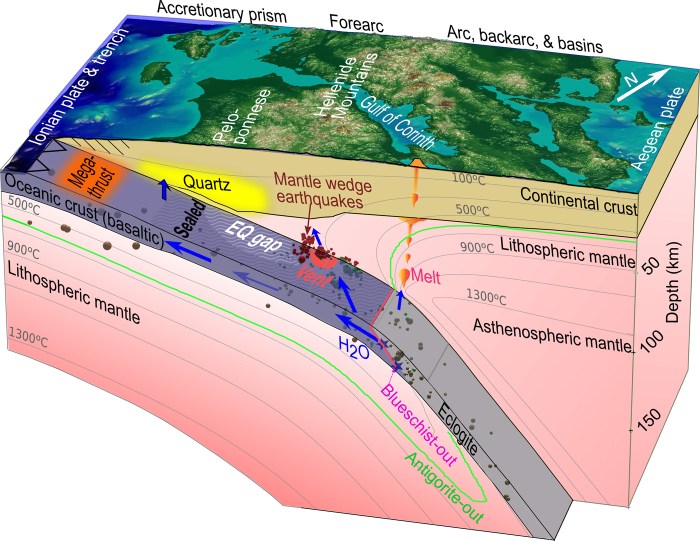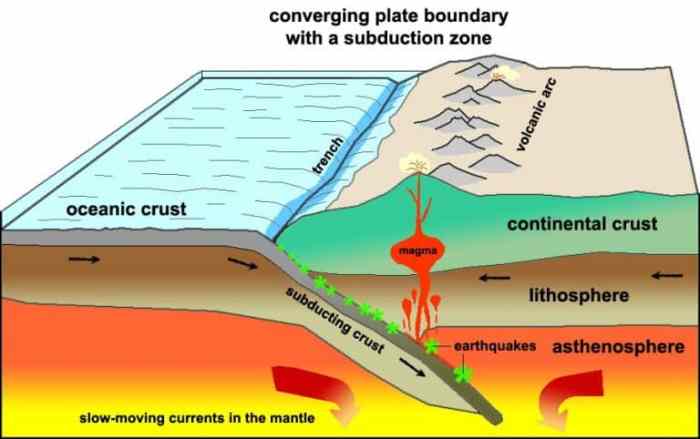Order the steps of continental volcanic arc formation. – Order the steps of continental volcanic arc formation, an intriguing geological process, unveils the intricate interplay between subduction zones and continental crust. This guide delves into the sequential stages of arc formation, exploring the role of subduction, magmatism, and volcanic activity in shaping these enigmatic structures.
Continental arcs, towering chains of volcanoes, stand as testaments to the dynamic forces that shape our planet. Understanding their formation not only provides insights into Earth’s geological history but also has implications for assessing volcanic hazards and unraveling the complexities of plate tectonics.
Continental Arc Formation Sequence: Order The Steps Of Continental Volcanic Arc Formation.
Continental arc formation is a complex process that involves the interaction of several tectonic plates. The initial stage of continental arc formation occurs when an oceanic plate subducts beneath a continental plate. As the oceanic plate descends into the mantle, it melts and produces magma.
This magma rises to the surface and forms volcanoes on the continental plate. These volcanoes are typically explosive and produce large amounts of ash and pumice.
Second Stage of Continental Arc Formation
The second stage of continental arc formation occurs when the subducting oceanic plate reaches the mantle. The mantle is a hot, semi-solid layer of rock that lies beneath the Earth’s crust. As the oceanic plate melts, it releases water and other volatiles into the mantle.
These volatiles lower the melting point of the mantle and cause it to melt. The molten mantle material rises to the surface and forms volcanoes on the continental plate.
Third Stage of Continental Arc Formation, Order the steps of continental volcanic arc formation.
The third stage of continental arc formation occurs when the subducting oceanic plate reaches the core-mantle boundary. The core-mantle boundary is a sharp boundary between the Earth’s mantle and its core. As the oceanic plate reaches the core-mantle boundary, it begins to sink into the core.
This process is called “slab rollback”. Slab rollback causes the continental plate to move away from the subduction zone. As the continental plate moves away, the volcanoes on the continental plate become less active.
Final Stage of Continental Arc Formation
The final stage of continental arc formation occurs when the subducting oceanic plate is completely consumed by the core. Once the oceanic plate is consumed, the subduction zone is no longer active. The volcanoes on the continental plate become extinct and the continental arc is no longer formed.
Subduction Zone and Continental Arc Relationship

Subduction zones are the primary driving force behind continental arc formation. Subduction zones occur when one tectonic plate moves beneath another tectonic plate. As the subducting plate descends into the mantle, it melts and produces magma. This magma rises to the surface and forms volcanoes on the overriding plate.
The volcanoes that form in subduction zones are typically explosive and produce large amounts of ash and pumice.
Subduction Zones and Continental Arc Magmatism
Subduction zones play a critical role in continental arc magmatism. The magma that is produced in subduction zones is typically rich in silica and aluminum. This type of magma is called “andesitic” magma. Andesitic magma is the primary component of continental arcs.
Relationship Between Subduction Angle and Continental Arc Type
The angle at which the subducting plate descends into the mantle has a significant impact on the type of continental arc that is formed. If the subduction angle is shallow, the continental arc will be wide and have a low elevation.
If the subduction angle is steep, the continental arc will be narrow and have a high elevation.
Continental Arc Magmatism
Continental arc magmatism is the process by which magma is produced in continental arcs. The magma that is produced in continental arcs is typically andesitic in composition. Andesitic magma is a type of magma that is rich in silica and aluminum.
The magma is produced by the melting of the mantle wedge above the subducting oceanic plate.
Role of Mantle Melting in Continental Arc Magmatism
The mantle wedge is a region of the mantle that lies above the subducting oceanic plate. As the oceanic plate descends into the mantle, it releases water and other volatiles into the mantle wedge. These volatiles lower the melting point of the mantle wedge and cause it to melt.
The molten mantle material rises to the surface and forms volcanoes on the continental arc.
Types of Magmas Produced in Continental Arcs
The types of magmas that are produced in continental arcs vary depending on the composition of the mantle wedge. If the mantle wedge is composed of peridotite, the magma that is produced will be andesitic in composition. If the mantle wedge is composed of eclogite, the magma that is produced will be tonalitic in composition.
Continental Arc Structure

Continental arcs are typically long, narrow mountain ranges that are located on the margins of continents. The mountains in continental arcs are formed by the volcanoes that are produced by the subduction of oceanic plates. The volcanoes in continental arcs are typically explosive and produce large amounts of ash and pumice.
Role of Volcanic Activity in Continental Arc Formation
Volcanic activity is the primary driving force behind continental arc formation. The volcanoes that form in continental arcs are the result of the melting of the mantle wedge above the subducting oceanic plate. The magma that is produced by the melting of the mantle wedge rises to the surface and forms volcanoes on the continental arc.
Different Types of Volcanoes Found in Continental Arcs
There are a variety of different types of volcanoes that can be found in continental arcs. The most common type of volcano is the stratovolcano. Stratovolcanoes are large, cone-shaped volcanoes that are built up by layers of lava and ash.
Other types of volcanoes that can be found in continental arcs include cinder cones, shield volcanoes, and calderas.
Continental Arc Examples

There are many examples of continental arcs around the world. Some of the most well-known continental arcs include the Andes Mountains in South America, the Cascade Range in North America, and the Japan Arc in Asia.
Characteristics of Each Continental Arc
Each continental arc has its own unique characteristics. The Andes Mountains are the longest continental arc in the world, stretching for over 7,000 kilometers along the western coast of South America. The Cascade Range is a relatively young continental arc, with most of its volcanoes forming within the last 10 million years.
The Japan Arc is a complex continental arc that is made up of several different segments.
Significance of Continental Arcs in Global Tectonics
Continental arcs are important features in global tectonics. They are the sites of some of the most active volcanoes in the world. Continental arcs also play a role in the formation of new continental crust. The magma that is produced by the melting of the mantle wedge above the subducting oceanic plate can rise to the surface and form new landmasses.
Frequently Asked Questions
What is the initial stage of continental arc formation?
The initial stage involves the subduction of an oceanic plate beneath a continental plate, leading to the formation of a magmatic arc.
How do subduction zones contribute to continental arc magmatism?
Subduction zones provide a source of heat and volatiles that trigger the melting of mantle rocks, generating magmas that rise to form volcanic arcs.
What are the different types of volcanoes found in continental arcs?
Continental arcs host a variety of volcanoes, including stratovolcanoes, cinder cones, and calderas, each with distinct eruptive styles and compositions.